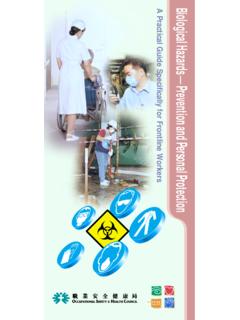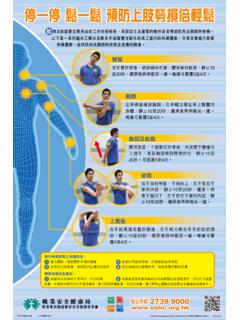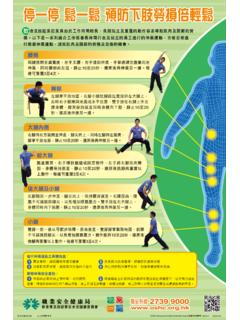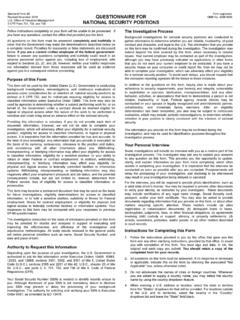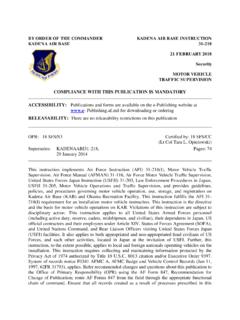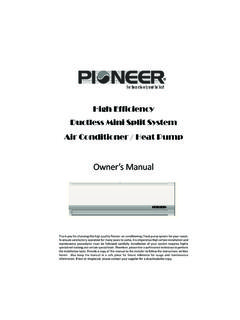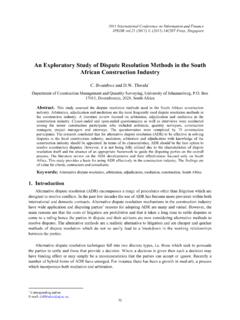Transcription of Contents
1 1 contents Page 1. Introduction 3 2. Electrical safety legislation 4 3. Sources of electricity 5 4. Electricity principles 6 5. Electrical hazards 7 6. Special process (electric arc welding) 9 7. Protective measures for prevention of direct electrical contact 10 8. Safety devices 11 9. Safe use of electricity 13 10. Installation and maintenance of electrical work 17 11. First-aid for electric shock 18 Attachment: Inspection checklist of electrical safety 19 Note: The information contained in this booklet and the attachment is for reference only, and is subject to any appropriate adjustments related to the situation of your own working environment. This booklet is also available in Chinese version231. IntroductionAs a source of power, electricity is used in all aspects of life.
2 In the home and at work, electricity provides the power for everything from domestic appliances to industrial machines, from office equipment to electric tools. When compared to the potential dangers of machinery and chemical substances, electrical hazards can be easily overlooked. Unfortunately, this neglect often causes serious accidents and loss of property. Many of these accidents can be prevented as they are mainly caused by electricity users who lack basic safety Electrical safety legislationThe legislation involving electrical safety is the Electricity Ordinance (Chapter 406) as enforced by the Electrical and Mechanical Services Department and Factories and Industrial Undertakings (Electricity) Regulations (Chapter 59) enforced by the Labour Electricity Ordinance The Ordinance requires that people engaged in electricity work, or with contractors and electricity generation facilities, must be registered.
3 It also stipulates the safety requirements of electricity supply, electricity wiring and electrical products, etc. There are several subsidiary regulations of the Electricity Ordinance, including: 1. Electricity Supply Regulations 2. Electricity Supply (Special Areas) Regulations 3. Electricity (Exemption) Regulations 4. Electricity (Registration) Regulations 5. Electricity (Wiring) Regulations 6. Electrical Products (Safety) Regulation 7. Electricity Supply Lines (Protection) Factories and Industrial Undertakings (Electricity) Regulations The Regulations apply to industrial undertakings in which electricity is generated, transformed, distributed or used. The purpose is to supervise the safety of electrical facilities and working processes, etc.
4 Of relevant Accident Statistics These table reviews the industrial accident statistics involving electricity in the past Sources of electricityThe electricity we used is mainly supplied by local electricity companies, and is connected to our homes, working places and other areas, through distribution : 50 Hz Voltage: Single-phase: 220 Volts (V) alternating current 3-phase: 380 Volts (V) alternating currentThe electricity used in our homes and offices is single-phase alternating current, and 3-phase alternating current normally serves the Electricity principlesOhm s LawA complete electrical circuit is composed of 3 elements: Current, Voltage and correlative relationship can be shown by the following formula: V = I x RThe above formula applies to the human body during an electric shock, provided that the voltage remains constant and there is Resistance (R) in the human body.
5 A reduction in resistance in the human body will lead to higher electrical currents passing through it, and any injury will be more serious. Element Unit Abbreviation Voltage (V) Volts V Current (I) Amperes A Resistance (R) Ohms 75. Electrical Electric shock Electric shock refers to the electricity passing through the human body, affecting the normal function of the heart, lungs and nervous system. Ventricular fibrillation caused by electricity is the main reason for death from electric shocks. Electric shocks may indirectly lead to accidents, falling from heights and bruising due to body trauma etc. Ventricular fibrillation involves a series of disordered contractions of the heart s ventricular muscle fibres, which prevents regular heartbeat.
6 Under normal conditions, the human heart rate is from around 60 to 100 times per minute. During an electric shock, heartbeat may increase up to several hundred times per minute. When the heart cannot sustain such rapid contraction and relaxation, it may stop beating and cause FailureElectric shock may affect normal brain function and stop FailureIf current passes through the heart, it will disrupt the rhythmic pumping action and eventually stop the heart accidents due to electric shocks are caused by current passing through the chest. When such accidents occur, chest muscles cramp, leading to suffocation and to get freeafter an electric shockAn electric shock causes con-tinuous contraction of the forearm muscles, thus stop-ping the victim getting free from the electric effect of currents passing through various parts of the Burns During an electric shock, the current passing through the body may lead to burns on the skin, muscles or internal organs.
7 As electric shocks and burns are closely related, preventative measures should be considered Fires and explosions High temperatures caused by currents under abnormal conditions, may result in accidental fires and explosions. The common causes leading to high temperatures include: Overloading of electricity Insulator breakdowns or short circuits Improper contact of electrical circuit Improper maintenance of electrical appliances or wiring Poor ventilation, flames, sparks or metallic solutions due to electric arc welding are not controlled, hazardous fires or explosions can Special process (electric arc welding)Electric arc welding is commonly used for metallic welding and cutting. The various hazards from welding or cutting include the following:Hazards Burns Sparks or hot metal fragments from arc welding or cutting may result in serious burns.
8 Proper protection is essential. Radiation If proper eye protectors are not used while welding or cutting, radiation or other objects may hurt the welder. Safety measures: Wear proper personal protective equipment, approved eye protectors, hand shields, leather aprons, leather gloves and safety shoes, etc. Electric shock It is dangerous to conduct the arc welding in a wet environment or on rainy days. Safety measures: Avoid electric welding in such conditions. Earth the tools and equipment properly. Adjust the current required for welding to the minimum amount. Add an automatic voltage regulator to reduce the open-circuit no-load voltage of the transformer output, reducing the chance of getting an electric shock. Poisonous fumes and gases Inhalation of poisonous fumes and gases during welding or cutting may cause serious health problems.
9 Safety measures: Provide adequate ventilation. Use exhaust systems to remove poisonous fumes and Protective measures for prevention of direct electrical contactThe following procedures will prevent the human body from contact with electrical conductors,wiring, electrical sources, measures Insulation Shield the electrical conductor with an insulator to prevent direct contact Obstacles Place obstacles to prevent any accidental contact with the electrical conductor Barriers or enclosures Create barriers or enclosures that prevent any direct contact with the electrical conductor Placing out of reach This prevents accidental contact with the electrical conductor118. Safety Fuse Normally, a fuse is a copper wiring with a set current fusion value.
10 If the current exceeds the set fusion value, the fuse will blow and the current is cut-off, thus preventing overloading. A fuse must be installed on live wires. When replacing a fuse, the new fuse must be same current fusion value as the old Circuit breakers (MCB) Circuit breakers are based on the principle of the electromagnetic field. The current entered may enable the coils of the circuit breaker to magnetise. When the current exceeds the set value ( , overloading), the magnetisation intensifies, switching off the circuit breaker and disconnecting the electric Earthing Earthing provides a low resistance way of discharging electricity to the ground in case of current leakage. This means that during an electric shock, the current passes through the earth wire and is prevented from entering the human body and causing Earth leakage circuit breaker (ELCB or RCD) Current leakage protection is also called residual current protection or earthing fault current protection.
